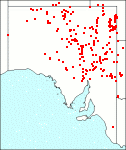Family: Fabaceae
Swainsona phacoides
Citation:
Benth. in T.L. Mitchell, J. Trop. Austral. 363 (1948) subsp. phacoides.
Synonymy: S. uniflora J. Black, Trans. R. Soc. S. Aust. 57:152 (1933); S. phacoides Benth: var. argyrophylla J. Black, Fl. S. Aust. 322 (1924); S. phacoides Benth. var. oocarpa J. Black, Trans. R. Soc. S. Aust. 59:257 (1935); S. phacoides Benth. var. parviflora Benth., FI. Aust. 2:218 (1864).
Common name: Dwarf swainsona (or swainson-pea), lilac Darling pea.
Description:
Variable perennial, suberect or spreading and only 4-5 cm high to large spreading or prostrate herbs with stout stems to 60 cm long; indumentum on stem and leaves rather dense, with appressed cylindrical medifixed shiny hairs often crinkled and/or very asymmetrically attached; leaves 2-15 commonly 6-7 cm long, with 5-7 leaflets on smaller plants to 17 on larger ones, linear or narrow-oblong or elliptic or oblanceolate to narrow-obovate, 5-30 x 1.5-4 mm, acute, obtuse to strongly retuse, slightly channelled above, pubescent on both sides, the terminal one often the longest; stipules lanceolate, 1-7 mm long, finally scarious, pubescence as on the leaves.
Flowers usually 9-10 mm long, in larger specimens to 14 mm, on pedicels 1.5-4 mm long with densely pubescent basifixed dark and/or white hairs; peduncles slender, 3-4 cm long, 1-3-flowered in small specimens, in larger specimens stout and to 20cm long and to 10-flowered; flowers congregated terminally on hoary peduncles with basifixed hairs; bract about as long as the pedicel, scarious; bracteoles at the base of the calyx, subulate, to 1 mm long; calyx 6-7 mm long, pubescent usually with rather long and more or less spreading mostly dark hairs, teeth triangular or narrow-triangular, relative length of teeth and tube very variable; petals purple, occasionally white or yellow; standard suborbicular and hardly notched to wide-ovate and widely notched, about as long as broad, with 2 confluent plate-like calli at the summit of the claw, rarely tending to punctate; wings oblong-obovate, shortest, auriculate, glabrous or ciliate on the inner margin, claw 2-3 mm long; keel semicircular in outline, obtuse, with shallow folds near the auricle; claw slender or stout, 2-4 mm long; ovary subsessile, cylindrical, densely white-pubescent; style slender, cylindrical, tapering to a very slender apex, evenly bearded all along onto the straight tip.
Pod cylindrical and 10-30 x c. 4 mm or ovoid and 10-15 x 7-12 mm, the apex broadly rounded, the suture deeply impressed, with basally attached mostly spreading hairs, to 40-seeded; seed cordate, c. 1.7 x c. 1.5 mm, olive-green to brown, smooth.
Published illustration:
Cunningham et al. (1982) Plants of western New South Wales, p. 419.
|
|
Distribution:
|
usually on sandy plains.
S.Aust.: NW, LE, GT, FR, EA, EP, MU. W.Aust.; N.T.; Qld; N.S.W.; Vic.;.
|
Conservation status:
native
Flowering time: May — Oct.
|

SA Distribution Map based
on current data relating to
specimens held in the
State Herbarium of South Australia
|
Biology:
Palatable to stock.
Taxonomic notes:
This species exhibits a number of varying characters combined in different ways without constant correlation. It shows similarity with S. stipularis which has a rigid style dilated and flattened basally.
Author:
Not yet available
|

